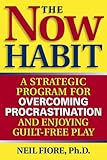One of the most common pitfalls to productivity is procrastination. While being productive means accomplishing something, procrastinating is just the opposite. If we procrastinate, nothing will get done. Time will pass by without results and before long we may notice how far behind we have been left by others.
Here is a confession: I’m a procrastinator. There are some tasks I don’t like that I procrastinate on. The most obvious one – since I’m a lecturer – is grading. I like all other aspects of being a lecturer except grading the exam papers.
 That’s why I was excited when I learned about a book on overcoming procrastination that is widely recommended on the web: The Now Habit: A Strategic Program for Overcoming Procrastination and Enjoying Guilt-Free Play by Neil Fiore. I read the book with the expectation that I would find the cure to my procrastination habit. Let’s see what the book has to offer.
That’s why I was excited when I learned about a book on overcoming procrastination that is widely recommended on the web: The Now Habit: A Strategic Program for Overcoming Procrastination and Enjoying Guilt-Free Play by Neil Fiore. I read the book with the expectation that I would find the cure to my procrastination habit. Let’s see what the book has to offer.
Inside The Now Habit
The book is divided into ten parts that consist of Introduction and nine chapters. Below is the summary of each of them.
Introduction
The typical procrastinator completes most assignments on time, but the pressure of doing work at the last minute causes unnecessary anxiety and diminishes the quality of the end result. You can cultivate the Now Habit instead: the ability to put aside the fear of failure, the terror of feeling overwhelmed, and low self-esteem, and focus your mind on what you can start now.
The Now Habit starts with a new definition:
Procrastination is a mechanism for coping with the anxiety associated with starting or completing any task or decision
Advice such as “just do it”, “try harder”, and “get organized” is based on the old definition: “Your problem is procrastination. If only you weren’t so lazy you could do it.”
1. Why We Procrastinate
The Now Habit perspective does not accept that laziness, disorganization, or any other character defect is the reason you procrastinate. We procrastinate when we fear a threat to our sense of worth and independence.
There are three kinds of fear: fear of failure, fear of being imperfect (perfectionism), and fear of impossible expectations (being overwhelmed). The fear of judgment is the key fear that stems from over-identifying who you are, your worth as a person, with your work.
There is one main reason why we procrastinate: it rewards us with temporary relief from stress. We can become addicted to the rewards of procrastination, learning to use it in three main ways:
- As an indirect way of resisting pressure from authorities.
- As a way of lessening fear of failure by providing an excuse for a disappointing, less-than-perfect performance.
- As a defense against fear of success by keeping us from doing our best.
2. How We Procrastinate
Knowing how you procrastinate is even more important than knowing why. You can use your awareness of negative patterns to redirect your energy toward forming positive habits.
First of all, we need a structure to keep us aware of the passage of time and how we spend it. Keeping an inventory for three days of every waking activity is a way to gain control over where your time goes. As you review a typical week’s activities, you will see patterns you may wish to change.
It’s not enough though. You also need to keep a procrastination log, which links the avoided activity to a specific thought and justification. You can use the procrastination log to identify the attitudes and self-talk that are keeping you from getting started and then replaced them with a focus on one small step.
3. How to Talk to Yourself
The Now Habit system focuses on language because how you talk to yourself represents the attitudes and beliefs that determine how you feel and act. Changing how you talk to yourself is a powerful tool for disengaging from procrastination patterns of hesitation and indecision.
There are five negative attitudes or self-statements that lead to procrastination. You should replace them with positive ones. Here they are:
- “I have to”
Replace it with “I choose to”. - “I must finish”
Replace it with “When can I start?” - “This project is so big and important”
Replace it with “I can take one small step“. - “I must be perfect”
Replace it with “I can be perfectly human“. - “I don’t have time to play”
Replace it with “I must take time to play“.
4. Guilt-Free Play, Quality Work
To sustain high levels of motivation and lessen the urge to procrastinate in the face of life’s demands for high-level performance, we need guilt-free play to provide us with periods of physical and mental renewal. So plan recreation in your weekly schedule.
There are two ways to stimulate action: push method and pull method. Push method aims to stimulate action through fear of punishment. Pull method, on the other hand, aims to stimulate action through proper rewards. If you want to get genuine and lasting motivation, pull method is the way to go.
To use pull method, you should make the periods of work shorter (less painful) and the rewards more frequent and immediate (more pleasurable) – interlacing short periods of work with breaks and rewards.
5. Overcoming Blocks to Action
There are three major fears that block action and create procrastination: the terror of being overwhelmed, the fear of failure, and the fear of not finishing.
Here are three Now Habit tools to handle them:
1. Three-dimensional thinking and the reverse calendar
It’s used to combat the terror of being overwhelmed. Three-dimensional thinking means seeing the entire process, mentally spread the work out over the days and weeks ahead. It’s the opposite of two-dimensional thinking where you see the entire work all at once.
You can apply three dimensional thinking by using a reverse calendar. Reverse calendar is a calendar that starts with the ultimate deadline for your project and then moves back, step by step, to the present where you can focus your energy on starting. It consists of several smaller deadlines – all within your control.
2. The work of worrying
It’s used to tackle the fear of failure. Worrying can warn you of danger and evoke action to prepare for that danger. By alerting yourself to a potential danger without establishing a plan for how you will cope, you have done only half of the job of worrying. You should also do the other half: developing an action plan.
3. Persistent starting
It’s used to tackle fear of finishing. Many procrastinators can get started but create blocks to finishing through negative self-statements. Learn to avoid being overwhelmed and focus on what you can do. Essentially, all large tasks are completed in a series of starts. Keep on starting, and finishing will take care of itself.
6. The Unschedule
The Unschedule is a weekly calendar of committed recreational activities. It’s also a record of your productive, uninterrupted work. This method of scheduling encourages you to start earlier on your project, because you now realize how little time is actually available.
The Unschedule avoids one of the traps of typical programs for overcoming procrastination that begin with the scheduling of work. Instead, the Unschedule reverses this process, beginning with an image of play.
Here are some Unschedule guidelines:
- Schedule only previously committed time such as meetings, recreation, socializing.
- Record and take credit only for periods of work that represent at least thirty minutes of uninterrupted work.
- Reward yourself with a break or change to a more enjoyable task after each period worked.
- Keep track of the number of quality hours worked each day and each week.
7. Working in the Flow State
The flow state is a state that is both intensely focused and exceptionally calm. Getting into this state of “mental overdrive” on command takes some training, but it can be learned.
For you to work creatively, and very rapidly, the critical and logical functions of your brain (generally attributed to the left hemisphere) must be temporarily suspended. Concerns about perfection, accuracy, and acceptance must be put aside temporarily. Later, the left side can organize them to fit the requirements of the project or customer.
8. Fine-Tuning Your Progress
Any program of habit change, if it is to continue working for you over time, needs to be fine-tuned and tailored to fit you.
One way to do that is to plan a controlled setback. Here you use your preferred method of procrastinating while watching yourself closely and make a mental record of the thoughts and anxieties that send you escaping to procrastination. Your planned setback will point out when you are most likely to procrastinate.
Understanding and controlling distracting thoughts is also important for fine-tuning your work habits. In most cases, you can just write down the distractions to deal with them later.
In addition, how you set your goals strongly influences your ability to recommit to them and bounce back after a setback. To ensure that your way of setting goals helps you overcome procrastination, make commitments only to those goals and paths that you can wholeheartedly embrace.
9. The Procrastinator in Your Life
All of us must work with, live with, and relate to individuals whose own problems with procrastination affect us negatively. Unless we have a firm grasp of the basic causes and patterns of procrastination, most of us will unwittingly reinforce procrastination patterns in those whom we manage, counsel, and love.
Successful leaders and managers address this problem by communicating in terms that elicit commitment rather than compliance, by focusing on manageable objectives rather than on overwhelming expectations, and by providing praise for steps taken in the right direction rather than just criticizing mistakes.
Conclusion
Besides Getting Things Done, The Now Habit is the best productivity book I’ve read so far. Procrastination is one of the worst productivity pitfalls and The Now Habit presents a ground-breaking way to view and solve it. I must admit that I was a victim of the old definition of procrastination (which says that procrastination is the problem) and this book opens my eyes to see procrastination differently.
While reading the book, I also applied the technique of having positive self-talk to handle my procrastination problems and I’m happy with the results. I can now see the tasks I’m procrastinating on in a positive way and I’m more eager to start.
Since I’ve been applying the principles in Getting Things Done for about two years, the next step for me is to apply the principles in The Now Habit.
This article is part of June 2008 theme: Productivity




Thanks for the review. Not that I needed it because I read the book a few months ago and I liked it, so I have to agree with you. What I find difficult with these kind of books is when you read it you really get into it, but after a while, you’re reading other books and you forget about the techniques that you learned. If you want to avoid this I think you really have to implement them into your life, that’s te only way to find out of they work for you!
Hi Donald, this is a very thorough review. We’ve got the same problem and I need to work with mine as well.
Thanks for sharing it, it’s really helpful.
I want to share my article here. It’s a reflection after I read the book on guidance for busy Christian. Hope you enjoy the article.
http://www.reason4smile.com/2007/12/08/busy-2-the-procrastinator-busy-for-delaying/
Thanks,
Robert
I read The Now Habit shortly after a major push to become more GTD compliant. I found that it meshed very well with David Allen’s philosophy and was a great addition to my productivity tool belt.
I will be interested to read how integrating the two systems go in your case.
Great Post. I would say that procrastination is a little bit of laziness and fear. More laziness than anything else.
Procrastination isn’t necessarily a bad thing if the task doesn’t need to be accomplished right away. If you’ve ever heard of Parkinson’s Law, then you may agree. When I’m working on a project with a short deadline, I tend to be much more efficient in getting the job done well.
I find the best way to get myself to do something I want to do, but am too lazy or uncommitted to accomplish consistently is to put myself in a situation such that action is inevitable. For example, it’s much easier to go to the gym when I have someone to keep me accountable. Since I hate letting people down, it’s easier to just go rather than get that awful feeling in my stomach !
I like the point about persistent starting. Second guessing and hesitation tends to encourage procrastination. Biting the bullet, for better or worse, always helps in moving from inaction to action.
Awesome post!
If you get a chance check out my blog; I haven’t written anything specifically about productivity, but it’s on the list!
Check out Chester’s Tips
I look at procrastination as one more bad habit that we struggle (well, some do) to break.
We may have developed a pattern that we automatically default to when we are challenged by a new, desired behaviour.
In order to change a habit it takes recognition, determination, practice and some trusted tools and techniques. A little bit of forgiveness (of self) is also necessary.
New habits take time to build and it helps to understand that our brains have adjusted to the old pattern or way of doing things.
Remember the first time you got behind the wheel of a car. You really had to concentrate, didn’t you? Now, you just jump in the car, without any thought. That’s a learned habit…even if we don’t think of it that way. Continuing on, how did you become so proficient behind the wheel? Attention and practice.
How do you facilitate that? By using the power of your heart which scientists now know have a direct link to the “thinking brain”. This is the one that allows you to reason and determine the best course of action for yourself.
Farfield,
I agree with you. We will get full benefits only if we implement the books. But, if we read many books, we won’t have the resources (energy, willpower) to implement them all. So I think we should prioritize the books. For me, Getting Things Done is a book that get priority. Looks like The Now Habit will be another.
Robert,
Thanks for the article! Busy Christian’s Guide to Busyness sounds like an interesting book. If only I can get it here 🙂
Jeredb,
That’s also what I think about The Now Habit: it’s a good complement to Getting Things Done. GTD helps us manage the tasks in our workflow and The Now Habit helps us start working on the tasks. Integrating the two systems is something I’m looking forward to in my life.
Chester,
Interesting tip. For now I will concentrate on improving my self-talk, but this is something I should try later on.
By the way, keep up the good work on your blog!
Marianna,
Your point on using the power of the heart is especially interesting to me. I just knew from you that the heart has been scientifically linked to the “thinking brain”.
this is so true. Today I realized that I am not a procrastinator in life, which makes feel good about myself.
Pheng,
That’s good because feeling good about ourselves is essential to becoming a producer. Guilt will just hinder our productivity.
[…] http://www.lifeoptimizer.org/2008/06/16/review-the-now-habit/ […]
[…] finally got around to reading the The Now Habit by Dr. Neil Fiore. The book has been reviewed a bunch of times, so I just want to pull out a few facts that I found particulairly useful and which […]
[…] the first and second reasons. For the third reason you can read defeating procrastination habit or my review of The Now […]
Hello Donald
Though many month passed since you wrote it, I thank you very much for this review! I’m happy to find people who made the same experience as I hope to make: Getting things done and The now habit fit very well. It was not easy to find GTD in Switzerland some years ago. I’m applying it for about two years soon and am very happy with it. Some month ago I was looking for a book about overcoming procrastination and found The now habit could be best for me. Today I can get it in the bookshop (in fact, a big one if not the biggest) – they had to order it… Yesterday I thought that GTD and The now habit will probably be the only too books I need to become more productive.
I already know some things about myself and why in specific situation I am procrastinating and now – after reading your post – I am of good hope that my findings will account to overcome these very tiring states.
However, I also found out that I don’t really know little things that makes me happy or what “recreational” does mean to me. I used to smoke as a break – very bad. So, the unscheduling will probably be the biggest task for me when implementing the method. …but maybe with the nicest effects when done so! The second part of the subtitle could become crucial in my case, also without the “guilt-free”.
Thanks again and kind regards from Zurich!
Regula,
It’s nice to hear about your experience in increasing productivity and overcoming procrastination. Yes, The Now Habit is a good complement to GTD for the taking action part. Thanks for stopping by and I wish you all the best!
[…] simpler way is to just track how many productive sessions you have in a day. The Now Habit (here is my review) suggests a session to be thirty minutes long but it’s up to you. The important thing is to […]
Donald-
I just found out about “The Now Habit” today on amazon while looking for a similar book.
I have spent the last couple weeks alternating between periods of intense productivity and intense procrastination/lethargy and, eventually, depression.
Thanks for taking the time to summarize the key points of this book.
I can’t wait to get my own copy and get started!
Thanks again,
Ian
[…] Review: The Now Habit (lifeoptimizer.org) […]
[…] then taking a break. Two well-known versions of this are the Neil Fiore’s The Now Habit [review and summary] and the Pomodoro technique. They take some different approaches, but both can be good with […]
So… What if, being a serious procrastinator, I procrastinate reading long books on procrastination.
How would you get around that, would you “force” yourself to do it, inherently creating resistance and reluctance as the book says. Or would you give in and procrastinate?